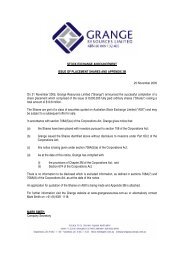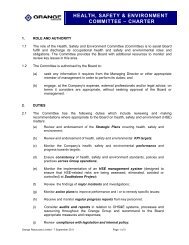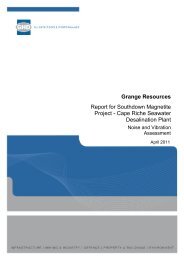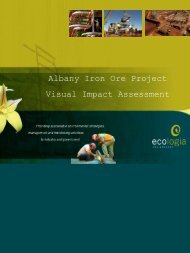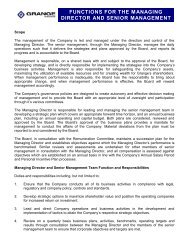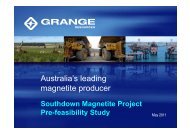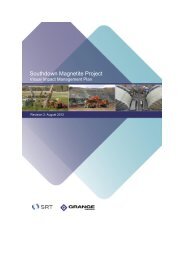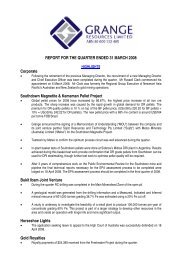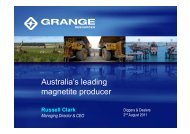2012 Annual Report (2 April 2013) - Grange Resources
2012 Annual Report (2 April 2013) - Grange Resources
2012 Annual Report (2 April 2013) - Grange Resources
Create successful ePaper yourself
Turn your PDF publications into a flip-book with our unique Google optimized e-Paper software.
<strong>2012</strong> ANNUAL REPORT<br />
19<br />
PAGE<br />
Pumping the concentrate slurry<br />
100 km to the port<br />
Final magnetite concentrate will be<br />
thickened and transported through a<br />
110 km pipeline to the Port of Albany,<br />
where it will be filtered and stored for<br />
loading onto cape size ships. A second<br />
pipeline will return the filtered water back<br />
to the mine site so it can be used again in<br />
the process. Both pipelines are buried.<br />
Increasing Albany’s Port<br />
Capacity<br />
Subject to a decision to proceed, a<br />
concentrate export facility would be<br />
built on 7 hectares of reclaimed land<br />
at Albany Port, immediately east of the<br />
existing woodchip terminal site. The plan<br />
incorporates a filtration plant, storage<br />
shed, new berth and ship loading facility.<br />
Deepening and widening a 9.5 kilometre<br />
approach channel will enable 200,000<br />
tonne cape size ships to use the port.<br />
Whilst minimal dust generation is expected<br />
because of the high moisture content<br />
of the concentrate, the shed will be fully<br />
enclosed, under negative pressure and<br />
fitted with dust extraction equipment.<br />
The development would more than<br />
treble Albany’s current port capacity<br />
from approximately 4 Mt per annum to<br />
14 Mt per annum. The design has been<br />
developed in close consultation with the<br />
Albany Port Authority and in line with the<br />
Public Environmental Review approved in<br />
November 2010.<br />
A new source of water and<br />
power supply<br />
The plan also envisages that a seawater<br />
desalination plant would be constructed<br />
25 km from the mine to supply the plant<br />
with 11 GL per annum of water. Power<br />
for the mine site would be provided by a<br />
new 278 kilometre 330kv transmission line<br />
from Muja to Southdown, to be built by<br />
Western Power.<br />
Operations planning<br />
The Southdown operation will be modelled on <strong>Grange</strong>’s existing Savage River operation<br />
in Tasmania operating on a 24/7 basis for 365 days per year.<br />
Construction planning & schedule<br />
Subject to a decision to proceed the project will engage an experienced construction<br />
management company to coordinate a series of fixed price contracts to minimise<br />
risk and the number of interfaces. The Southdown Joint Venture continues to work<br />
alongside the community, including traditional owners of the land, to ensure a safe and<br />
environmentally responsible project.<br />
MINERAL RESOURCES AND ORE RESERVES<br />
– SOUTHDOWN PROJECT<br />
Mineral <strong>Resources</strong> Estimate<br />
The mineral resource estimate for the Southdown Project is as follows:<br />
As at December <strong>2012</strong> As at February <strong>2012</strong><br />
Tonnes Grade Tonnes Grade<br />
(Mt) %DTR* (Mt) %DTR*<br />
Measured 423.0 37.8 423.0 37.6<br />
Indicated 86.8 38.7 87.4 38.4<br />
Inferred 747.1 30.9 710.6 31.5<br />
Total 1,256.9 33.7 1,221.0 34.1<br />
* Davis Tube Recovery – a measure of recoverable magnetite<br />
The Mineral Resource as at December <strong>2012</strong> includes minor updates to the Mineral<br />
Resource reported to the ASX on 16 February <strong>2012</strong>. These updates included a detailed<br />
review of oxidation levels, minor reinterpretation of wireframes around fault zones and a<br />
complete review of historical analytical data. The net effect of these updates has been a<br />
relative 2% increase in tonnes, 1.35% decrease in DTR and an overall 0.6% increase in<br />
contained concentrate.<br />
This Mineral Resource was completed by Ben Pollard of BMGS Perth Pty Ltd and has<br />
been defined using geological boundaries and a cut-off grade of 10 wt% DTR (Davis<br />
Tube Recovery) and includes minor internal dilution. Further details of the total Mineral<br />
Resource methodologies and assumptions are provided in the ASX announcement dated<br />
16 February <strong>2012</strong>.<br />
The information in this report which relates to the Mineral <strong>Resources</strong> of the Southdown Project is based<br />
on information compiled by Michael Everitt who is a full-time employee of <strong>Grange</strong> <strong>Resources</strong> Limited and<br />
a Member of the Australasian Institute of Mining and Metallurgy. Michael Everitt has sufficient experience<br />
which is relevant to the style of mineralisation and type of deposit under consideration and to the activity<br />
for which he is undertaking to qualify as a Competent Person as defined in the JORC Code (2004).<br />
Michael Everitt consents to the inclusion of this information in this statement of Mineral <strong>Resources</strong> in the<br />
form and context in which it appears.



